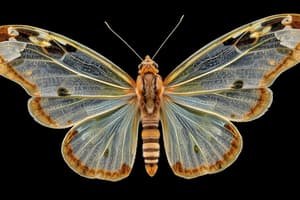Podcast
Questions and Answers
What is phylogeny?
What is phylogeny?
- A system for grouping species
- The evolutionary history of a species (correct)
- A two-part scientific name of a species
- The ordered division and naming of organisms
What is taxonomy?
What is taxonomy?
The ordered division and naming of organisms.
Binomial nomenclature refers to a one-part name for a species.
Binomial nomenclature refers to a one-part name for a species.
False (B)
Which of the following describes hierarchical classification?
Which of the following describes hierarchical classification?
What do systematists use to depict evolutionary relationships?
What do systematists use to depict evolutionary relationships?
What does a phylogenetic tree represent?
What does a phylogenetic tree represent?
Phylogenetic trees indicate when species evolved.
Phylogenetic trees indicate when species evolved.
What are morphological and molecular homologies?
What are morphological and molecular homologies?
What does analogy mean in evolutionary biology?
What does analogy mean in evolutionary biology?
How do systematists evaluate molecular homologies?
How do systematists evaluate molecular homologies?
What is cladistics?
What is cladistics?
Flashcards are hidden until you start studying
Study Notes
Phylogeny
- Refers to the evolutionary history of a species or related species.
- Systematists employ fossil, molecular, and genetic data to elucidate evolutionary relationships.
Taxonomy
- Involves the ordered division and naming of organisms.
- Carolus Linnaeus established a taxonomy system focusing on resemblance, introducing two-part names for species and hierarchical classification.
Binomial Nomenclature
- The scientific name for a species consists of two parts: genus and specific epithet.
- The genus name is capitalized; both parts are italicized, forming a complete name to identify the species.
Hierarchical Classification
- Introduced by Linnaeus, this system categorizes species from broad to specific: domain, kingdom, phylum, class, order, family, genus, species.
- A taxon is any group at any hierarchical level; broader taxa cannot be directly compared across lineages.
Linking Classification and Phylogeny
- Evolutionary relationships are visually represented using phylogenetic trees.
- Linnaean classification may not always align with phylogenetic relationships; PhyloCode emphasizes clades that include an ancestor and its descendants.
Phylogenetic Tree
- Represents hypotheses about evolutionary relationships, where branch points signify species divergence.
- Sister taxa share an immediate common ancestor; basal taxa diverge early in a group's history.
Learning from Phylogenetic Trees
- Trees illustrate descent patterns rather than phenotypic similarity.
- They do not provide timelines for species evolution or the extent of change in lineages.
Inferences
- Systematists gather morphologies, genes, and biochemistry data to infer phylogenies.
Morphological and Molecular Homologies
- Shared ancestry results in phenotypic and genetic similarities termed homologies.
- Organisms with similar structures or DNA are likely closely related compared to those with distinct characteristics.
Homology
- Defined as similarity arising from shared ancestry.
Analogy
- Refers to similarities due to convergent evolution, where different lineages develop similar adaptations under similar environmental pressures.
Sorting Homology from Analogy
- Bat wings are homologous as forelimbs and analogous as functional wings.
- Structures originating independently are homoplasies, often requiring fossil evidence for distinction between homologies and analogies.
Evaluating Molecular Homologies
- Systematists analyze comparable DNA segments using computer programs and mathematical tools.
- Molecular systematics aims to evaluate homologies and detect molecular coincidences.
Cladistics
- Categorizes organisms according to common descent.
- A clade encompasses an ancestral species and all its descendants, allowing for nested groupings within larger clades.
Studying That Suits You
Use AI to generate personalized quizzes and flashcards to suit your learning preferences.




